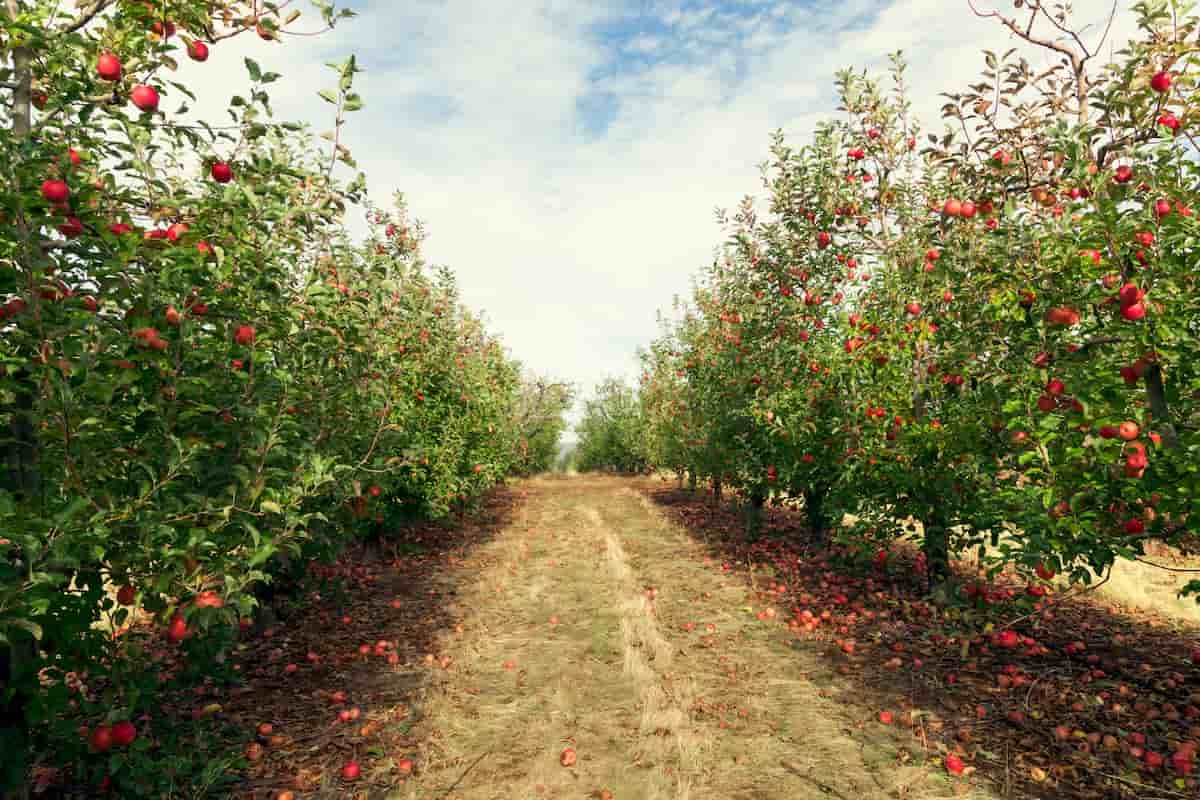Apple farming can be a highly profitable venture for farmers in the USA, but it requires careful planning and attention to detail. Below we learn the apple farming guide, the apple fruit production process commercially, and the apple cultivation guide for beginners.

How to Start Apple Farming in the USA
Market Research
Before starting an apple farm, it is essential to conduct market research to understand the demand for apples and the competition in your local market. This will help you determine the best apple varieties to plant, the ideal harvest season, and the best marketing channels to sell your apples. Research the local grocery stores, farmers’ markets, and wholesale buyers in your area to understand the apple market.
Farm Site
Once you have conducted market research, securing a suitable farm site is next. Choose a location with the right soil, adequate water supply, and favorable climate conditions. In general, apple trees require well-drained soil, full sunlight, a cold winter to break their dormancy, and moderate temperatures during the growing season. Consider leasing or purchasing the land based on your financial resources.
Business Plan
A well-developed business plan is essential for the success of any farming business, including apple farming. The business plan should outline your production goals, marketing strategies, financial projections, and management structure. A good business plan will help you secure financing and attract investors.
Apple Varieties
The choice of apple varieties to plant depends on your local market demand, climate, and soil. Popular apple varieties in the USA include Red Delicious, Honeycrisp, Fuji, and Granny Smith. Ensure you choose disease-resistant apple varieties to reduce the risk of pests and diseases.
Prepare the Land
Once you have secured the farm site and chosen the apple varieties, the next step is to prepare the land. Clear the land, till the soil, and add organic matter and fertilizers. Ensure that the land has adequate drainage and irrigation systems to support the growth of apple trees.
Plant the Trees
The best time to plant apple trees is during the dormant season, preferably in the fall or early spring. Ensure that you space the apple trees according to the recommended spacing for the apple variety. In general, apple trees should be spaced 12-15 feet apart to allow room for growth.
Pest and Diseases
Apple trees are vulnerable to pests and diseases, which can reduce yields and quality. Implement an integrated pest management (IPM) program to manage pests and diseases. This involves monitoring, prevention, and control measures. Use organic and biological controls wherever possible and avoid the use of pesticides.
In case you missed it: How to Grow Apples Organically: A Step-By-Step Guide for Beginners

Fertilize and Prune
Fertilizing and pruning the trees are critical for optimal apple production. Fertilize the trees based on soil test results and apple tree nutrient requirements. Prune the trees during the dormant season to remove dead wood, improve light penetration, and promote fruiting.
Harvest the Apples
Harvest the apples when they are ripe and at the desired maturity stage. Harvesting time varies depending on the apple variety and market demand. Proper harvesting techniques and storage are critical for maintaining fruit quality and shelf life. Ensure you use appropriate harvesting equipment and carefully handle the apples to avoid damage.
Seasonal Steps
Apple farming requires seasonal management to ensure optimal yield and quality. Below are some of the seasonal steps involved in apple farming:
Spring – This is the time when apple trees break their dormancy and start to grow. During this time, you should fertilize the trees, prune them, and remove any weeds that may have grown. You should also check for any signs of pests or diseases and take appropriate measures to control them.
Summer – During the summer, apple trees require adequate water to support growth and fruit development. Ensure you regularly water the trees and mulch around the base to conserve moisture. You should also continue to monitor for pests and diseases and take appropriate control measures.
Fall – This is the time when apple trees start to produce fruit. Harvest the apples when ripe, and store them in a cool, dry place. You should also continue to monitor for pests and diseases and take control measures as needed.
Winter – During the winter, apple trees enter dormancy. This is when you can prune the trees to control their size and shape. You should also check for any signs of winter injury, such as bark splitting, and take appropriate measures to protect the trees.
Intercropping
Intercropping can benefit apple farming, including increased yield, soil fertility, and pest management. Some of the crops that can be intercropped with apple trees include clover, alfalfa, and legumes. Clover, for example, can be grown between the rows of apple trees to provide nitrogen fixation and improve soil fertility. Legumes can also be grown as cover crops, which can help to suppress weeds and improve soil structure.
In case you missed it: How to Start Almond Farming in the USA: A Step-By-Step Production Guide

Conclusion
In conclusion, starting an apple farm in the USA requires proper planning, management, and resources. Additionally, seasonal management and intercropping can help to increase yield, soil fertility, and pest management in apple farming. You can establish and operate a successful apple farm with dedication and hard work.
- Feed Your Flock for Less: Top 10 Tips to Save on Chicken Feed
- Ultimate Guide to Ossabaw Island Hog: Breeding, Raising, Diet, and Care
- Hatching Answers: The Top 10 Reasons Your Chickens Aren’t Laying Eggs
- Eggs and Economics: Breaking Down the Cost of Raising Backyard Chickens
- Defend Your Greens: Proven Methods to Keep Iguanas Out of Your Garden
- Ultimate Guide to Cinnamon Queen Chicken: A Comprehensive Guide for Beginners
- Ultimate Guide to California Tan Chicken: Breeding, Raising, Diet, Egg-Production and Care
- Ultimate Guide to Marsh Daisy Chicken: Breeding, Raising, Diet, and Care
- 10 Types of Chicken Farming Businesses You Can Start for Profits